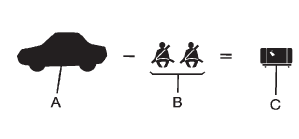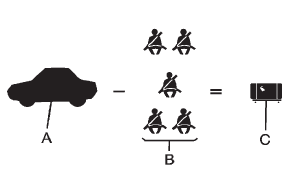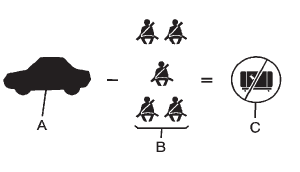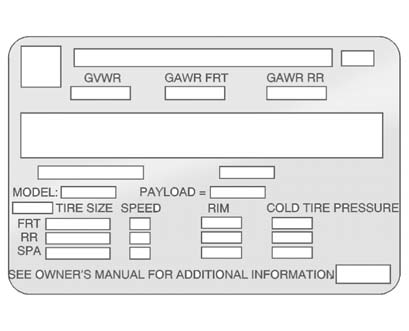 Cadillac Escalade: There is also important loading information on the vehicle Certification/Tire
label. It tells you the Gross Vehicle Weight Rating (GVWR) and the Gross Axle Weight
Rating (GAWR) for the front and rea
Cadillac Escalade: There is also important loading information on the vehicle Certification/Tire
label. It tells you the Gross Vehicle Weight Rating (GVWR) and the Gross Axle Weight
Rating (GAWR) for the front and rea
Steps for Determining Correct Load Limit
1. Locate the statement “The combined weight of occupants and cargo should never exceed XXX kg or XXX lbs” on your vehicle's placard.
2. Determine the combined weight of the driver and passengers that will be riding in your vehicle.
3. Subtract the combined weight of the driver and passengers from XXX kg or XXX lbs.
4. The resulting figure equals the available amount of cargo and luggage load capacity. For example, if the “XXX” amount equals 1400 lbs and there will be five 150 lb passengers in your vehicle, the amount of available cargo and luggage load capacity is 650 lbs (1400−750 (5 x 150) = 650 lbs).
5. Determine the combined weight of luggage and cargo being loaded on the vehicle. That weight may not safely exceed the available cargo and luggage load capacity calculated in Step 4.
6. If your vehicle will be towing a trailer, the load from your trailer will be transferred to your vehicle. Consult this manual to determine how this reduces the available cargo and luggage load capacity of your vehicle. See Trailer Towing for important information on towing a trailer, towing safety rules and trailering tips.

Example 1
A. Maximum Vehicle Capacity Weight for Example 1 = 453 kg (1,000 lbs)
B. Subtract Occupant Weight @ 68 kg (150 lbs) × 2 = 136 kg (300 lbs)
C. Available Occupant and Cargo Weight = 317 kg (700 lbs)

Example 2
A. Vehicle Capacity Weight for Example 2 = 453 kg (1,000 lbs)
B. Subtract Occupant Weight @ 68 kg (150 lbs) × 5 = 136 kg (750 lbs)
C. Available Cargo Weight = 113 kg (250 lbs)

Example 3
A. Maximum Vehicle Capacity Weight for Example 3 = 453 kg (1,000 lbs)
B. Subtract Occupant Weight @ 91 kg (200 lbs) × 5 = 453 kg (1,000 lbs)
C. Available Cargo Weight = 0 kg (0 lbs)
Refer to your vehicle's tire and loading information label for specific information about your vehicle's capacity weight and seating positions. The combined weight of the driver, passengers, and cargo should never exceed your vehicle's capacity weight.
Certification/Tire Label

A vehicle specific Certification/ Tire label is attached to the rear edge of the driver door. The label shows the size of your vehicle's original tires and the inflation pressures needed to obtain the gross weight capacity of your vehicle. This is called Gross Vehicle Weight Rating (GVWR). The GVWR includes the weight of the vehicle, all occupants, fuel, and cargo.
The Certification/Tire label also tells you the maximum weights for the front and rear axles, called Gross Axle Weight Rating (GAWR). To find out the actual loads on your front and rear axles, you need to go to a weigh station and weigh your vehicle. Your dealer can help you with this. Be sure to spread out your load equally on both sides of the center line.
Never exceed the GVWR for your vehicle, or the GAWR for either the front or rear axle. And, if you do have a heavy load, you should spread it out.
![]() WARNING
WARNING
Do not load the vehicle any heavier than the Gross Vehicle Weight Rating (GVWR), or either the maximum front or rear Gross Axle Weight Rating (GAWR). This can cause systems to break and change the way the vehicle handles. This could cause loss of control and a crash. Overloading can also shorten the life of the vehicle.
Your warranty does not cover parts or components that fail because of overloading.
The label will help you decide how much cargo and installed equipment your truck can carry.
Using heavier suspension components to get added durability might not change your weight ratings. Ask your dealer to help you load your vehicle the right way.
If you put things inside your vehicle—like suitcases, tools, packages, or anything else—they will go as fast as the vehicle goes. If you have to stop or turn quickly, or if there is a crash, they will keep going.
![]() WARNING
WARNING
Things you put inside the vehicle can strike and injure people in a sudden stop or turn, or in a crash.
- Put things in the cargo area of the vehicle. Try to spread the weight evenly.
- Never stack heavier things, like suitcases, inside the vehicle so that some of them are above the tops of the seats.
- Do not leave an unsecured child restraint in the vehicle.
- When you carry something inside the vehicle, secure it whenever you can.
- Do not leave a seat folded down unless you need to.
There is also important loading information for off-road driving in this manual. See “Loading Your Vehicle for Off-Road Driving” under Off-Road Driving .
 Tire and Loading Information Label
Tire and Loading Information Label
Label Example
A vehicle specific Tire and Loading Information label is attached to the center
pillar (B-pillar). With the driver door open, you will find the label attached below
the door lock po ...
 Add-On Equipment
Add-On Equipment
When you carry removable items, you may need to put a limit on how many people
you can carry inside your vehicle. Be sure to weigh your vehicle before you buy
and install the new equipment.
Notice: ...
See also:
Around ViewTM Monitor settings
To set up the Around View Monitor to your
preferred settings, push the SETTING button,
select the “Other” key and then select
the “Camera” key.
Predictive Course Lines:
When this ite ...
Octane rating
Premium unleaded gasoline with a Cost of Living Council (CLC) or Anti Knock Index
(AKI) octane rating of 91 or higher should be used.
NOTICE
Even a very small amount of leaded fuel will damag ...
Power washers
WARNING
Do not use power washers with circular-jet
nozzles (dirt grinders) to clean your vehicle, in
particular the tires. You could otherwise
damage the tires and cause an accident.
...






